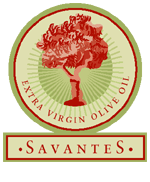The official receptacle for tasting olive oil is a specially designed blue glass with cover prescribed by the International Olive Oil Council. These are available in Spain and Italy for a cost of approximately 7 Euro’s.
- Most tastings are carried out with small (100ml) glasses or plastic cups with covers to keep the volatile elements in.
- Approximately 20-30ml of olive oil is poured into the tasting vessel.
- Professional tastings are limited to 3 or 4 oils a day, amateur tastings usually cover 6-8 oils.
- The olfactory senses tire fairly quickly and the perception of pepperiness in the back of the throat will become distorted through a cumulative effect.
- The olive oil can be swallowed or spat out.
- Between tastings the palate can be cleansed with small slices of apple and the mouth washed with mineral water.
- Bread is not a good medium for tasting as it has a strong taste, is often salty and can mask faults in the oil.
- Notes should be taken using tasting cards for future reference.
- Colour is not a good indicator of the quality or style of the oil and is not used as a parameter for evaluation other than in culinary contexts where colour may be important for presentation.
The following can be used as a guideline for olive oil tastings:
- Pour 25ml of the oil to be tasted into a numbered cup or glass.
- Place lid over cup or glass to retain aroma.
- Warm tasting cup to approximately 26?C by cupping it in hands or placing on a warming pad.
- When ready to taste, remove lid and inhale, noting the aroma
- characteristics of the oil.
- Replace lid and record descriptions.
- Repeat, if necessary, to further define aroma.
- Take approximately 10ml of oil into the mouth and spread all over the mouth noting the tastes of as the oil spreads over the palate:
- Fruitiness at the front of the palate
- Bitterness at the back and sides, and
- Pepperiness or piquancy at the back.
- Aspirate, taking in air through the mouth and expelling it through the nose to enhance the taste effects.
- Replace lid and record descriptions.
- Repeat after a short break if necessary to further define taste.
- Cleanse palate and take a break before the next sample.

